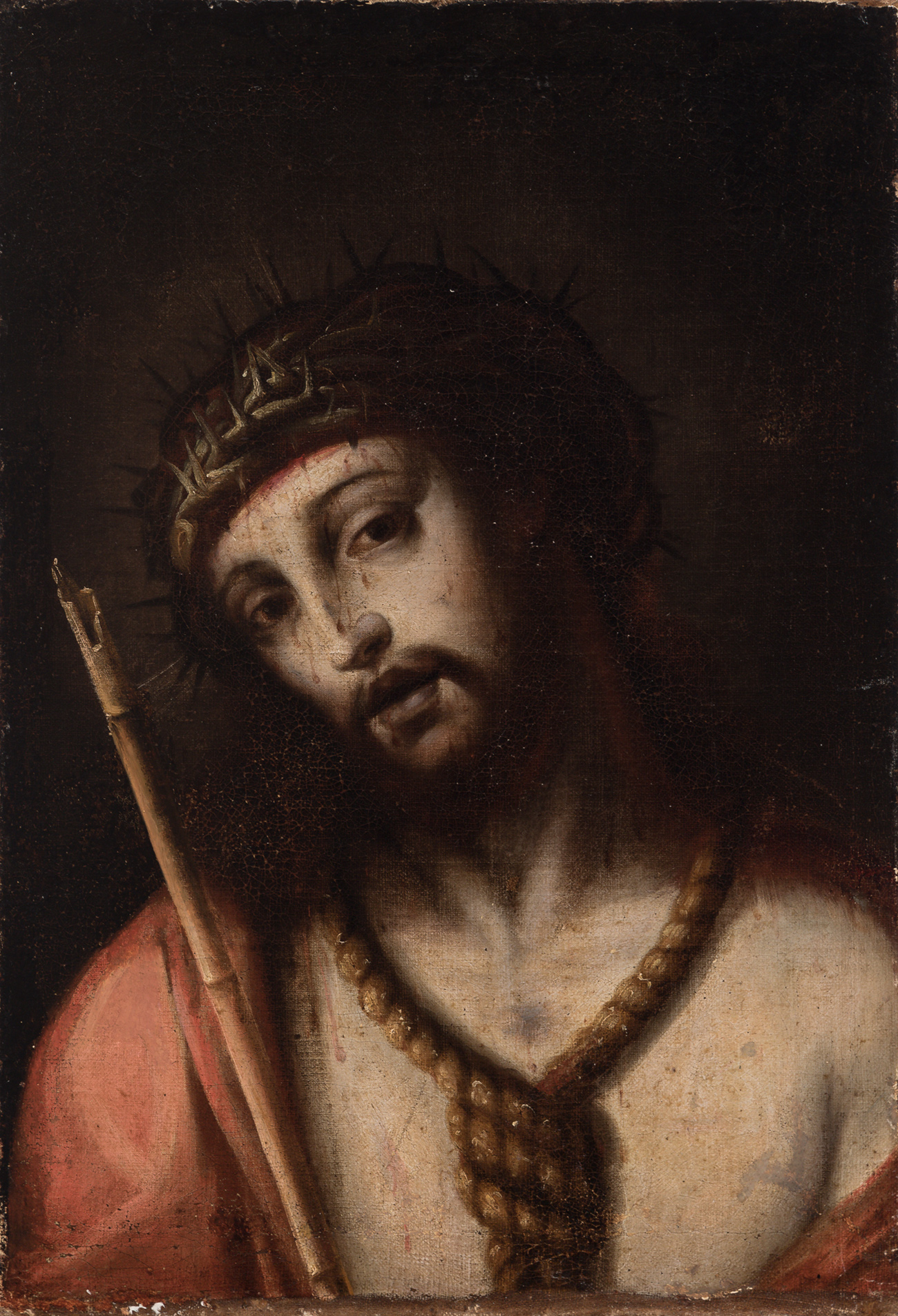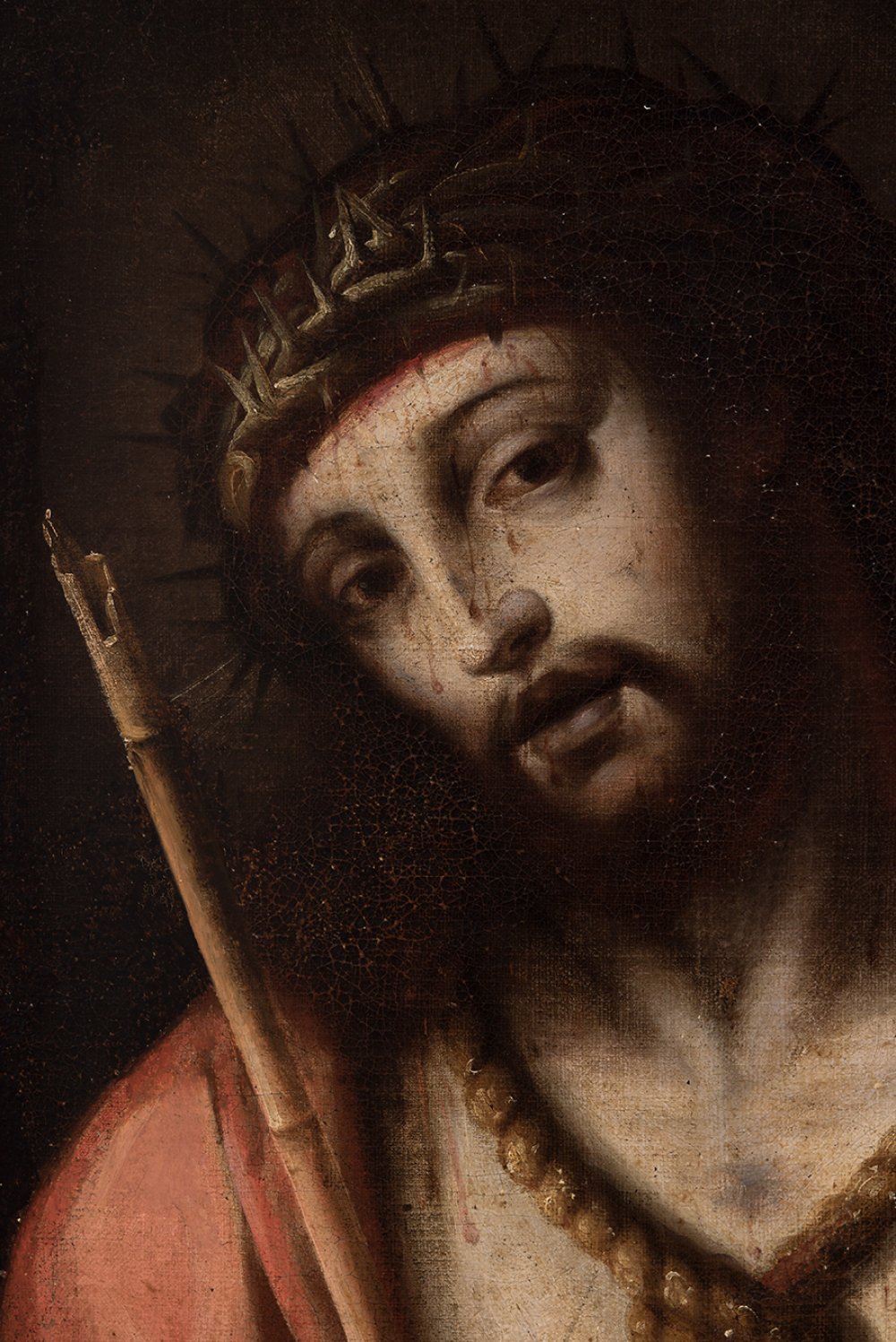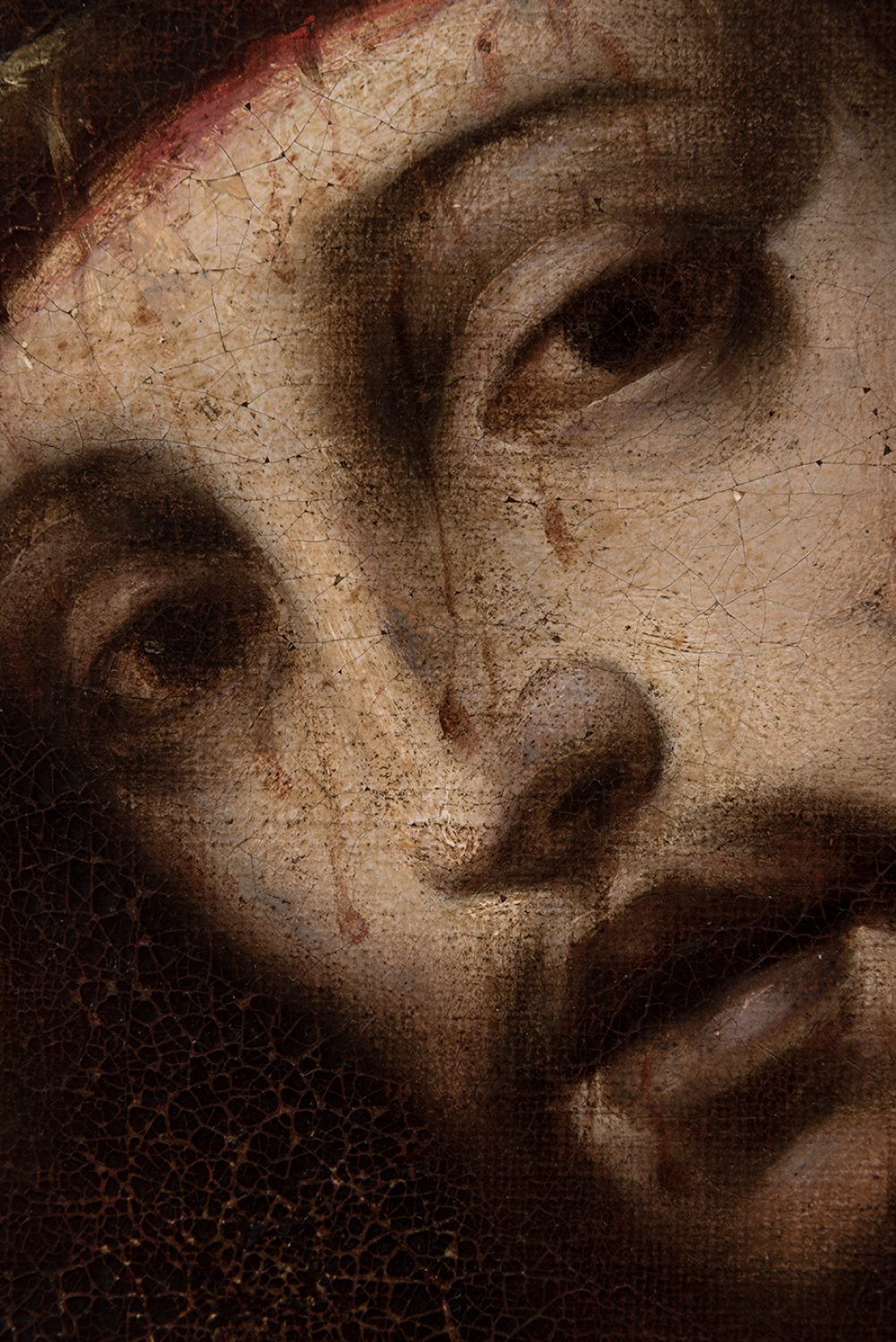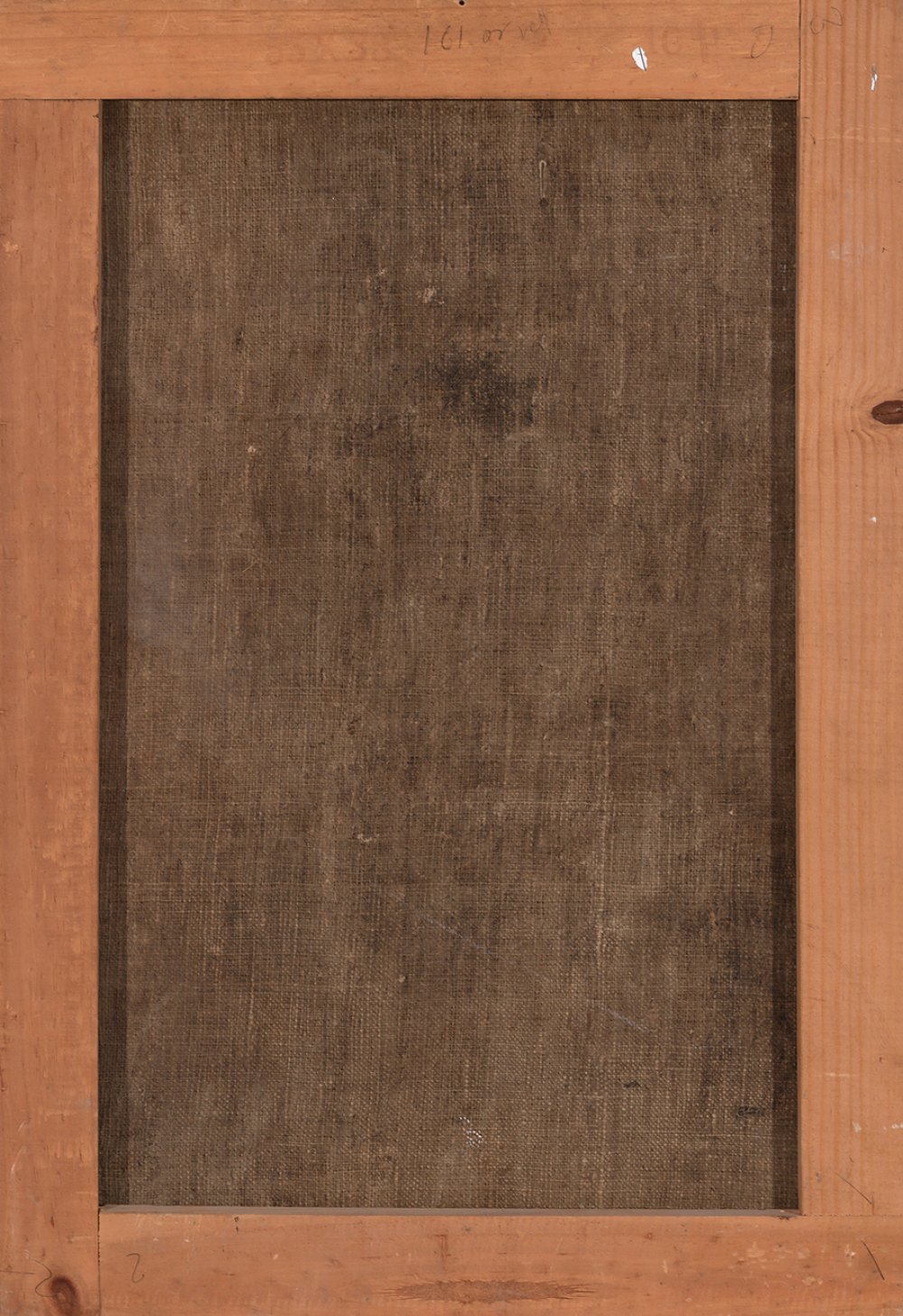41
Spanish school; second third of the 17th century."Ecce Homo".Oil on canvas. Re-drawn.It presents
1/5
Description
Spanish school; second third of the 17th century.
"Ecce Homo".
Oil on canvas. Re-drawn.
It presents slight jumps in the edges.
Measurements: 56 x 39 cm.
In this devotional canvas, painted for a particular altar or chapel, the theme of the Ecce Homo is represented, very common in this type of paintings. The composition is simple and clear, with Christ's face in the foreground, and the absence of narrative details enhances the expressive power and pathos, designed to move the soul of the faithful who pray before the image, in a tremendist sense very typical of the Baroque period in Catholic countries. The theme of Ecce Homo belongs to the Passion cycle and precedes the Crucifixion. Following this iconography, Jesus is presented at the moment when the soldiers mock him, after crowning him with thorns, dressing him in a purple tunic (here red, the symbolic colour of the Passion) and placing a reed in his hand, kneeling down and exclaiming "Hail, King of the Jews". The words "Ecce Homo" are those pronounced by Pilate when presenting Christ to the crowd; their translation is "behold the man", a phrase by which he mocks Jesus and implies that Christ's power was not such in comparison with that of the rulers who were judging him. Formally, this work is dominated by the highly contrasted and dramatic treatment of light, based on a spotlight that falls directly on the figure of Christ.
The piece faithfully follows the guidelines of Baroque naturalism, defined by the work of Antonio de Pereda y Salgado (Valladolid, 1611-Madrid, 1678), who was noted for his use of a naturalistic and tenebrist aesthetic, interested in a palette similar to that developed in Venice. Thus, visually, the treatment of light dominates, highly contrasted and effective, based on a spotlight that falls directly on the figure of Christ, creating expressive effects of chiaroscuro and leaving the rest in semi-darkness, against a dark, neutral background that further enhances the physical presence of the figure. The colour scheme is also derived directly from these models and is therefore based on a restricted, warm palette of ochre, earthy and carmine tones.
"Ecce Homo".
Oil on canvas. Re-drawn.
It presents slight jumps in the edges.
Measurements: 56 x 39 cm.
In this devotional canvas, painted for a particular altar or chapel, the theme of the Ecce Homo is represented, very common in this type of paintings. The composition is simple and clear, with Christ's face in the foreground, and the absence of narrative details enhances the expressive power and pathos, designed to move the soul of the faithful who pray before the image, in a tremendist sense very typical of the Baroque period in Catholic countries. The theme of Ecce Homo belongs to the Passion cycle and precedes the Crucifixion. Following this iconography, Jesus is presented at the moment when the soldiers mock him, after crowning him with thorns, dressing him in a purple tunic (here red, the symbolic colour of the Passion) and placing a reed in his hand, kneeling down and exclaiming "Hail, King of the Jews". The words "Ecce Homo" are those pronounced by Pilate when presenting Christ to the crowd; their translation is "behold the man", a phrase by which he mocks Jesus and implies that Christ's power was not such in comparison with that of the rulers who were judging him. Formally, this work is dominated by the highly contrasted and dramatic treatment of light, based on a spotlight that falls directly on the figure of Christ.
The piece faithfully follows the guidelines of Baroque naturalism, defined by the work of Antonio de Pereda y Salgado (Valladolid, 1611-Madrid, 1678), who was noted for his use of a naturalistic and tenebrist aesthetic, interested in a palette similar to that developed in Venice. Thus, visually, the treatment of light dominates, highly contrasted and effective, based on a spotlight that falls directly on the figure of Christ, creating expressive effects of chiaroscuro and leaving the rest in semi-darkness, against a dark, neutral background that further enhances the physical presence of the figure. The colour scheme is also derived directly from these models and is therefore based on a restricted, warm palette of ochre, earthy and carmine tones.
Auction Details
Shipping
T&Cs & Important Info
Ask seller a question
Spanish school; second third of the 17th century.
"Ecce Homo".
Oil on canvas. Re-drawn.
It presents slight jumps in the edges.
Measurements: 56 x 39 cm.
In this devotional canvas, painted for a particular altar or chapel, the theme of the Ecce Homo is represented, very common in this type of paintings. The composition is simple and clear, with Christ's face in the foreground, and the absence of narrative details enhances the expressive power and pathos, designed to move the soul of the faithful who pray before the image, in a tremendist sense very typical of the Baroque period in Catholic countries. The theme of Ecce Homo belongs to the Passion cycle and precedes the Crucifixion. Following this iconography, Jesus is presented at the moment when the soldiers mock him, after crowning him with thorns, dressing him in a purple tunic (here red, the symbolic colour of the Passion) and placing a reed in his hand, kneeling down and exclaiming "Hail, King of the Jews". The words "Ecce Homo" are those pronounced by Pilate when presenting Christ to the crowd; their translation is "behold the man", a phrase by which he mocks Jesus and implies that Christ's power was not such in comparison with that of the rulers who were judging him. Formally, this work is dominated by the highly contrasted and dramatic treatment of light, based on a spotlight that falls directly on the figure of Christ.
The piece faithfully follows the guidelines of Baroque naturalism, defined by the work of Antonio de Pereda y Salgado (Valladolid, 1611-Madrid, 1678), who was noted for his use of a naturalistic and tenebrist aesthetic, interested in a palette similar to that developed in Venice. Thus, visually, the treatment of light dominates, highly contrasted and effective, based on a spotlight that falls directly on the figure of Christ, creating expressive effects of chiaroscuro and leaving the rest in semi-darkness, against a dark, neutral background that further enhances the physical presence of the figure. The colour scheme is also derived directly from these models and is therefore based on a restricted, warm palette of ochre, earthy and carmine tones.
"Ecce Homo".
Oil on canvas. Re-drawn.
It presents slight jumps in the edges.
Measurements: 56 x 39 cm.
In this devotional canvas, painted for a particular altar or chapel, the theme of the Ecce Homo is represented, very common in this type of paintings. The composition is simple and clear, with Christ's face in the foreground, and the absence of narrative details enhances the expressive power and pathos, designed to move the soul of the faithful who pray before the image, in a tremendist sense very typical of the Baroque period in Catholic countries. The theme of Ecce Homo belongs to the Passion cycle and precedes the Crucifixion. Following this iconography, Jesus is presented at the moment when the soldiers mock him, after crowning him with thorns, dressing him in a purple tunic (here red, the symbolic colour of the Passion) and placing a reed in his hand, kneeling down and exclaiming "Hail, King of the Jews". The words "Ecce Homo" are those pronounced by Pilate when presenting Christ to the crowd; their translation is "behold the man", a phrase by which he mocks Jesus and implies that Christ's power was not such in comparison with that of the rulers who were judging him. Formally, this work is dominated by the highly contrasted and dramatic treatment of light, based on a spotlight that falls directly on the figure of Christ.
The piece faithfully follows the guidelines of Baroque naturalism, defined by the work of Antonio de Pereda y Salgado (Valladolid, 1611-Madrid, 1678), who was noted for his use of a naturalistic and tenebrist aesthetic, interested in a palette similar to that developed in Venice. Thus, visually, the treatment of light dominates, highly contrasted and effective, based on a spotlight that falls directly on the figure of Christ, creating expressive effects of chiaroscuro and leaving the rest in semi-darkness, against a dark, neutral background that further enhances the physical presence of the figure. The colour scheme is also derived directly from these models and is therefore based on a restricted, warm palette of ochre, earthy and carmine tones.
29th December - Old Masters
Sale Date(s)
Venue Address
Aragón 346, Barcelona
Calle Velázquez 7, Madrid
Carrer de Cirilo Amorós 55, Valencia
Barcelona
08009
Spain
General delivery information available from the auctioneer
Setdart offers Worldwide shipping
PICK UP IN ROOM: You can come and pick up your lots in our offices (Barcelona, Madrid or Valencia). At the moment of the withdrawal, you will be able to accept the current conditions of the lot by means of a document that you will sign.
YOU CAN SEND ANOTHER PERSON TO PICK UP: This person must present a signed authorization that you can find in our web page by accessing from BUY AT SETDART- LOGISTICS-DOWNLOAD AUTHORIZATION DOCUMENT. You can also send an e-mail with the requested data in AUTHORIZATION DOCUMENT to admin@setdart.com
Important Information
25% buyer´s premium
21% buyer´s premium at www.setdart.com















